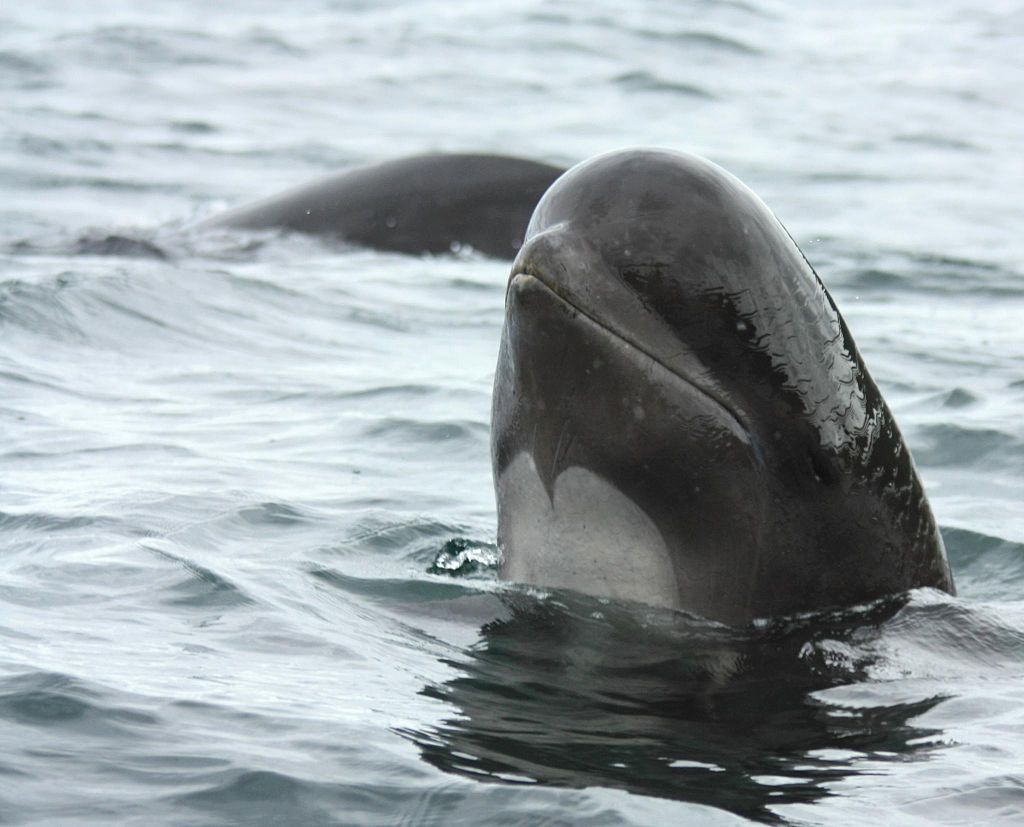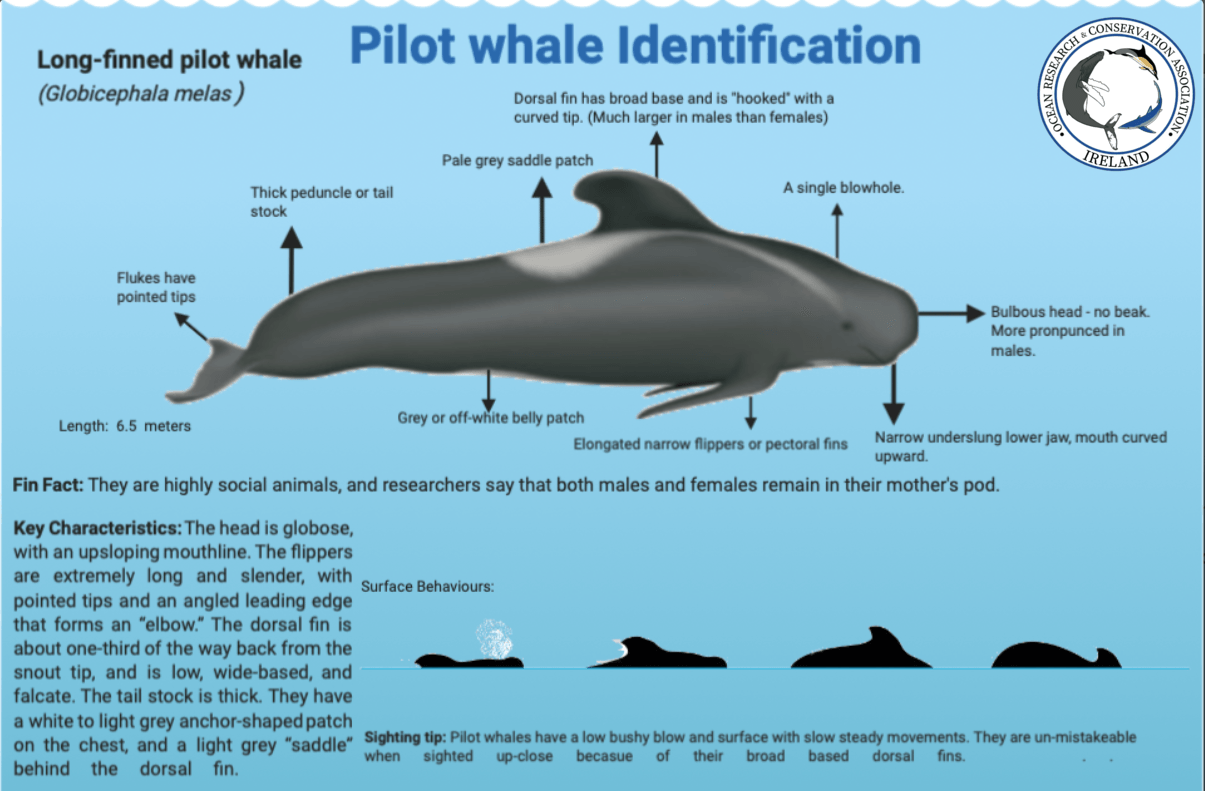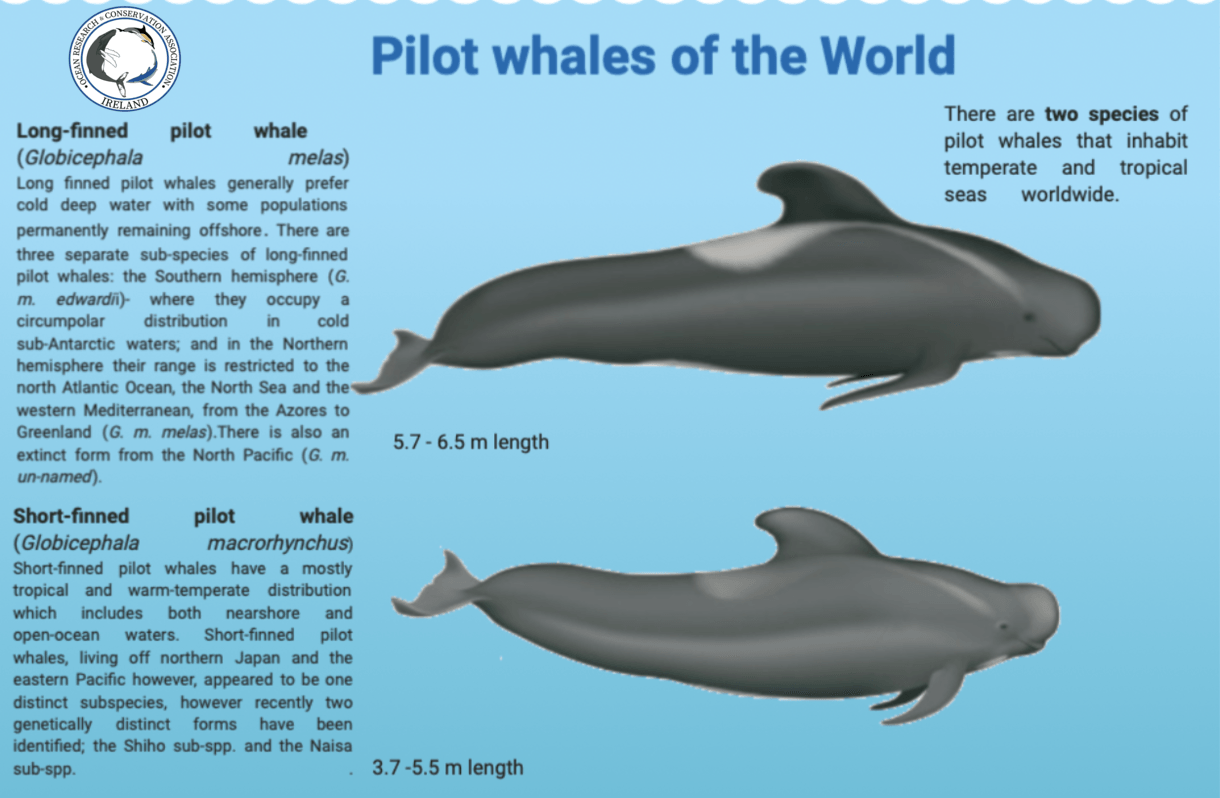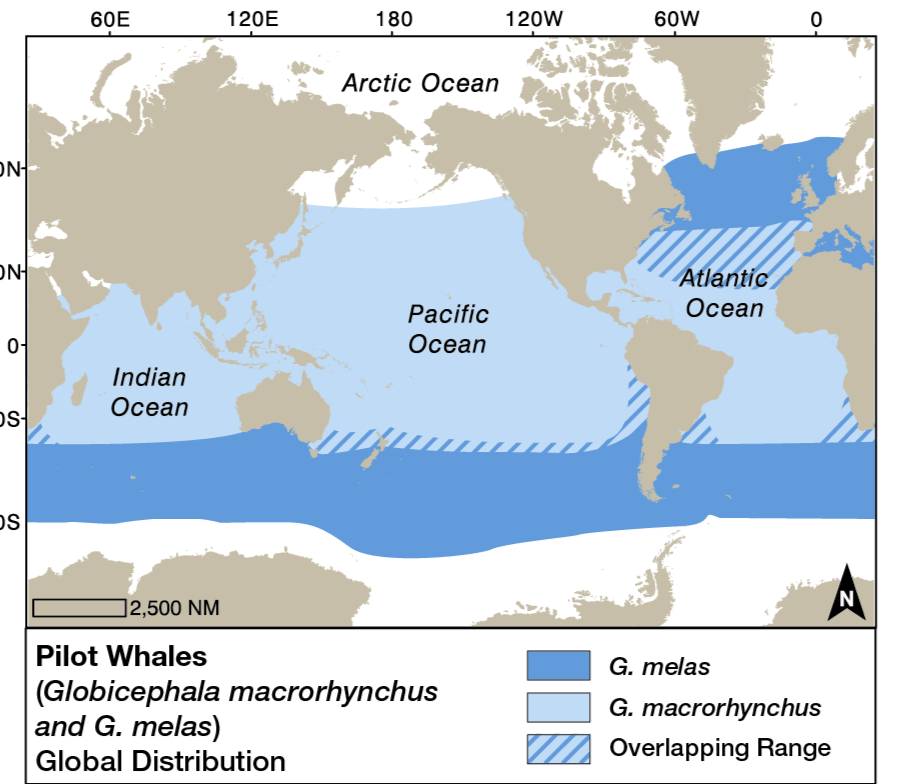Long-finned Pilot Whale
(Globicephala melas)
Classification:
Kingdom: Animalia
Phylum: Chordata
Class: Mammalia
Order: Artiodactyla
Infraorder: Cetacea
Family: Delphinidae
Genus: Globicephala
Species: G. melas
Traill, 1809
Get the Facts:
Pilot whales got their name as it was once believed that each observed group was navigated by a pilot or leader. Their Latin name, Globicephala, means ‘round head’, which is one of the main identifying features of the species. The long-finned pilot whale (Globicephala melas) is a large species of oceanic dolphin. It shares the genus Globicephala with the short-finned pilot whale. Long-finned pilot whales are known as such because of their unusually long pectoral fins.
Species Identification:
The long - finned pilot whale is similar to its counter species the short-finned pilot whale. It's head is globose, with an up-sloping mouth-line. The flippers are extremely long (18 to 27% of the body length) and slender, with pointed tips and an angled leading edge that forms an “elbow.” The dorsal fin is about one-third of the way back from the snout tip, and is low, wide-based, and falcate. The tail stock is deepened (remains of more-or-less uniform height from the saddle patch to just ahead of the flukes). Males have a larger, more bulbous head; larger, thicker dorsal fin; and deeper tail stock than do females.
Diet:
Pilot whales primarily feed on cephalopods (squid and octopus) but may also hunt fish (mackerel and cod) and forage on shrimp depending on their location and prey availability. They can dive to depths of 30 to 500 meters to look for prey.
Habitat:
In Ireland, pilot whales are generally observed in deep offshore waters such as those found off the north-west, in the Rockall Trough and the continental shelf slope, although their seasonal movements may reflect prey distribution. Most of the sightings of long-finned pilot whales in Irish waters have been offshore along the west coast. Stranding events of this species are often mass strandings due to their highly bonded social structures.
Behaviour:
Long-finned pilot whales are highly social animals that form tight-knit familial bonds. They have been recorded in groups of just a few animals to aggregations of over 1000 individuals. They are a curious species and will approach vessels, spy-hopping and investigating a ship. They rarely breach and have slow powerful movements as they surface. They also occasionally bow ride and tail slap, although they are often encountered resting motionless at the surface, which is known as logging.
Social Structure:
Long-finned pilot whales are very social in nature. They are usually seen in groups, which range in size from a couple of individuals to aggregations of over a thousand. However, 20 to 150 individuals are more commonly observed. Studies have shown that this species often forms small long-term social units made up of around 8-12 individuals. Genetic investigations of the pilot whales driven ashore in the Faroese hunts have shown a relatedness amongst whales, suggesting a matrilineal structure within social units. This means that calves - females and perhaps the males as well - remain with their mothers for life. Pilot whale groups have been observed socialising with other cetacean species common bottlenose dolphins (Tursiops truncatus), Atlantic white-sided dolphins (Lagenorhynchus acutus) and Risso's dolphins (Grampus giseus).
Vocalisations:
Long-finned Pilot Whales Globicephala melas are extremely vocal, using a combination of clicks, whistles and pulsed calls to communicate and interact with their environment. Pilot whales pulsed calls have been found to be similar to killer whales calls. Pilot whale feeding may sometimes require a high level of coordination between group members. Information needed for this behaviour appears to be transmitted by pulsed sounds and complex whistles. It was found that in general, when pilot whales were moving at higher speeds, regardless of behaviour, whistle total, as well as numbers of whistles, increased. Again, this may imply that the coordination necessary at or for higher speed is mediated by means of whistles, in particular complex ones. Other researchers related high proportions of complex whistles in pilot whales to high arousal situations, such as excitement. Therefore, pilot whale whistling may be used to maintain contact with group members and coordinate and integrate the movements of the herd. The simplest whistle types are emitted during low activity, restful behavior, while the more complex whistle types and pulsed sounds occur when behaviour is vigorous and energetic, and seems to involve more complex coordination among individuals of the group.
Reproduction:
Males become sexually mature at 12 to 13 years and females at 8 years. Breeding and mating usually takes place between the months of April and September in the North Atlantic and between October and April in the Southern Hemisphere. Every 3 to 6 years a single calf is born after a gestation period of 12 to 16 months. This is one of the longest known birth intervals of all cetaceans. At birth, calves measure about 1.5 to 1.9 meters and weigh about 75 kg. After 18 to 44 months, the calf stops nursing and is weaned by the cow. Older and/or un-reproductive females help care for calves in the social group.
Lifespan:
Long-finned pilot whales live to between 35 and 45 years for males and at least 60 years for females.
Pilot whales of the World:
There are 2 extant specie of pilot whales, the short-finned pilot whale (Globicephala macrorhynchus) and the long-finned pilot whale (Globicephala melas). There are two separate sub-species of long-finned pilot whales: the Southern hemisphere- where they occupy a circumpolar distribution in cold sub-Antarctic waters; and in the Northern hemisphere their range is restricted to the north Atlantic Ocean, the North Sea and the western Mediterranean, from the Azores to Greenland. They favour deep waters, although their seasonal movements may reflect prey distribution. It is long finned pilot whale which we find in Irish waters.
In 1760 two different types of short-finned pilot whales were first described by a Japanese naturalist called Yamase. Short-finned pilot whales with square-shaped heads in southern Japan were called the “Naisa form” and the round-head variety in northern Japan the “Shiho form”. Now recent genetic studies have confirmed these two forms of short-finned pilot whale. Read more here.
Population Status:
Both species of pilot whale are Least Concern on the IUCN Red List. In the Antarctic, there are an estimated 200,000 long-finned pilot whales.
Global Distribution:
This species has been described as "anti-tropical." Three distinct populations or subspecies of long-finned pilot whales are recognised: Southern Hemisphere, North Atlantic, and an unnamed extinct form in the western North Pacific. In the Southern Hemisphere, their range extends from 19° S to 60° S, but they have been regularly sighted in the Antarctic Convergence Zone (47° to 62° south) and in the Central and South Pacific as far south as 68° south. They have been documented near the Antarctic sea ice and associated with the colder Benguela and Humboldt Currents, which may extend their normal range, as well as the Falklands. The southern subspecies range includes Cape Province, South Africa; Chile; southern Australia; New Zealand; and Sao Pablo, Brazil. In the Northern Hemisphere, their range includes the U.S. east coast, Gulf of St. Lawrence, the Azores, Madeira, North Africa, western Mediterranean Sea, North Sea, Greenland and the Barents Sea. In the winter and spring, they are more likely to occur in offshore oceanic waters or on the continental slope. In the summer and autumn, long-finned pilot whales generally follow their favorite foods farther inshore and on to the continental shelf.
Conservation Threats:
Long-finned pilot whales were historically targeted by whalers and in the 1980's, the population in the eastern North Atlantic was estimated at over 700,000 individuals. Fisheries, particularly those for squid, may affect prey availability for pilot whales. In addition, pilot whales can become entangled in fishing gear. Drive hunts, where pilot whales are herded onto the shore, still take place in the Faroe Islands and over 1,500 whales are killed annually. Noise pollution from the use of underwater sonar for military purposes and oil and gas exploration may interfere with pilot whale vocalisations, cause injury and even death in the case of mass strandings.







